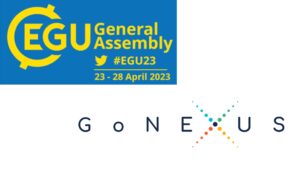
Celebrating Adrian’s PhD thesis on assessing the WEFE nexus
A part of GoNEXUS is celebrating the achievements of it’s junior scientists. Adrián González-Rosell, GoNEXUS researcher at the UPM, successfully defended his doctoral thesis in July 2023.
His thesis’s title was “Assessing the Water-Energy-Food Nexus: a novel participatory framework that combines system dynamics and cross-impact analysis to address cross-sectoral challenges in Andalusia” and it was developed as part of GoNexus and under the supervision of Professor of María Blanco.
Adrían’s research focused on the development of a new participatory WEF nexus framework that facilitates the co-design and evaluation of nexus solutions. The defence took place at the UPM’s School of Agricultural, Food and Biosystems Engineering. It marks an important step in exploring the Water-Energy-Food nexus and offers a promising framework for addressing cross-sectoral challenges.
Abstract
In today’s world, ensuring water, energy and food security, as well as conserving ecosystems are some of the most pressing sustainability challenges. Our current systems of food production, energy use, and water management often operate in silos. However, these sectors are, by nature, interconnected, food production requires both water and energy, while pumping, treating, and transporting water require energy, and energy production requires water, among many other interrelationships. This siloed approach to management leads to a lack of coordination and significant trade-offs across systems.
Moreover, this lack of coordination across sectors and socioeconomic activities has negative consequences for ecosystem conservation, which is vital for ensuring natural resource security. To tackle these issues, it is imperative to design policies or solutions that can effectively address sectoral and cross-sectoral challenges. The water-energy-food (WEF) nexus approach is a systemic and integrated approach designed to manage resources and coordinate sectors comprehensively.
By increasing efficiency, reducing trade-offs, building synergies, and improving governance across sectors and resources, the nexus approach has the potential to enhance water, energy, and food security. These characteristics make the WEF nexus an effective approach for supporting policymaking.
Consequently, the nexus approach has gained considerable attention in the last decade, leading the scientific community to develop new methodologies and adapt existing tools to address cross-sectoral challenges, and guide policymaking efforts. Despite the advancements and ongoing efforts, some of these methodologies are too theoretical, conceptual, or complex to put into practice. Achieving effective governance of the WEF nexus remains elusive, making it difficult to address water-energy-food security and ecosystem conservation.
Within the scope of this PhD thesis, we have conducted a literature review and identified up to eleven main features in methodologies and tools that are necessary to effectively evaluate the WEF nexus. Based on these features and our knowledge, we selected four criteria that are crucial to operationalize the nexus:
- tools that integrate quantitative and qualitative information,
- tools capable of analysing cross-sectoral policies,
- tools capable of assessing at different spatial scales,
- and tools capable of simulating future scenarios at different temporal scales.
After evaluating various methodologies and tools that address the nexus, we have found no methodology or tool that meets all four criteria. Therefore, the overarching objective of this thesis is to fill this gap in nexus studies by developing a novel participatory WEF nexus framework for co-designing and evaluating nexus solutions, encompassing these four criteria.
The Solution Evaluation Framework (SEF) consists of five main phases:
- identifying nexus solutions,
- nexus dialogues,
- nexus modelling,
- nexus evidence,
- and nexus-coherence assessment.
Throughout the evaluation process, the framework integrates various methodologies. In the nexus dialogues phase, we engaged stakeholders and experts from different nexus sectors to identify challenges, co-designed solutions and understood the cross-sectoral interlinkages using Fuzzy Cognitive Mapping (FCM).
In the nexus modelling phase, we applied system dynamics models (SDM) to simulate different solution scenarios and quantified cross-sectoral interlinkages.
Finally, in the nexus-coherence assessment phase, we utilised cross-impact analysis (CIA) and network theory to integrate quantitative and qualitative methodologies and measure the synergies and trade-offs of implementing a nexus solution.
The other objective of this thesis was to test the usefulness and applicability of the developed framework. To achieve this, the framework was applied to a practical case study involving an increase in irrigation water prices in Andalusia (Spain) for the horizon of 2030. Following the methodology of the SEF, we worked with a panel of experts representing various sectors in Andalusia. Additionally, a system dynamics model was developed to simulate the WEF nexus system in the region. Finally, cross-impact analysis (CIA) and network theory were used to evaluate the solution.
The results of the case study revealed that there is a sensitive relationship between water availability, irrigation costs and agricultural production, mainly due to the high level of technology in agricultural irrigation systems in the region. An increase in water price could generate synergies by promoting water security and ecosystem conservation. However, trade-offs were observed, particularly impacting the food sector in the region. The main challenges encountered in applying the framework were the integration of qualitative and quantitative information and the reconciliation of spatial and temporal scales across sectors.
Beyond the obtained results, the evaluation of this case study allowed us to demonstrate the capability of the SEF to evaluate nexus solutions by uncovering hidden properties, identifying leverage points, and highlighting key aspects of the complex cross-sectoral system. The framework can be adapted to accommodate different case studies, considering their unique challenges and spatial and temporal scales.
Furthermore, it facilitates the evaluation and coordination of multiple policies simultaneously, thereby contributing to nexus-coherence policymaking, which gives it a competitive advantage over other methodologies focused on nexus analysis.
To conclude, participatory approaches that combine qualitative and quantitative methods prove suitable for identifying and evaluating solutions aimed at improving WEF nexus governance.



